

Māori: Ōtākou Whakaihu Waka
| |
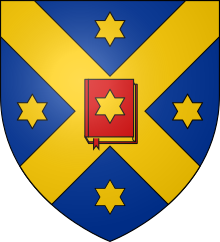
| |
| Motto | Latin: Sapere aude |
|---|---|
Motto in English | Dare to be wise |
| Type | Public research collegiate university |
| Established | 1869; 152 years ago |
| Endowment | NZD $279.9 million (31 December 2021)[1] |
| Budget | NZD $756.8 million (31 December 2020)[2] |
| Chancellor | Stephen Higgs |
| Vice-Chancellor | Helen Nicholson (acting)[3] |
Academic staff | 1,744 (2019)[4] |
Administrative staff | 2,246 (2019)[4] |
| Students | 21,240 (2019)[4] |
| Undergraduates | 15,635 (2014)[4] |
| Postgraduates | 4,378 (2014)[4] |
| 1,579 (2019)[4] | |
| Location |
,
, New Zealand (Māori: Ōtepoti, Ōtākou, Aotearoa) 45°51′56″S 170°30′50″E / 45.86556°S 170.51389°E / -45.86556; 170.51389 |
| Campus | Urban/University town 45 hectares (110 acres) |
| Student Magazine | Critic |
| Colours | Dunedin Blue and Gold |
| Affiliations | MNU |
| Website | https://www.otago.ac.nz |
 | |
The University of Otago (Māori: Ōtākou Whakaihu Waka[5]) is a public research collegiate university based in Dunedin, Otago, New Zealand. Founded in 1869, Otago is New Zealand's oldest university and one of the oldest universities in Oceania.[6]
The university was created by a committee led by Thomas Burns,[7] and officially established by an ordinance of the Otago Provincial Council in 1869.[8] Between 1874 and 1961 the University of Otago was a part of the federal University of New Zealand, and issued degrees in its name.[9]
Otago is known for its vibrant student life, particularly its flatting, which is often in old houses. Otago students have a long-standing tradition of naming their flats.[10][11][12] The nickname for Otago students, "Scarfie," comes from the habit of wearing a scarf during the cold southern winters.[13] The nickname "Scarfie" has morphed into the nickname "Breather" in recent years.[14][15] The university's graduation song, Gaudeamus igitur, iuvenes dum sumus ("Let us rejoice, while we are young"), acknowledges students will continue to live up to the challenge, if not always in the way intended. The university's student magazine, Critic, is New Zealand's longest running student magazine.

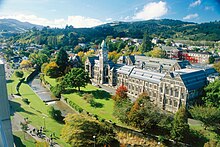

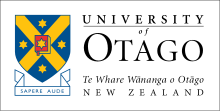
The Otago Association's plan for the European settlement of southern New Zealand, conceived under the principles of Edward Gibbon Wakefield in the 1840s, envisaged a university.
Dunedin leaders Thomas Burns and James Macandrew urged the Otago Provincial Council during the 1860s to set aside a land endowment for an institute of higher education.[16] An ordinance of the council established the university in 1869, giving it 100,000 acres (400 km2) of land and the power to grant degrees in Arts, Medicine, Law and Music.[17] Burns was named Chancellor but he did not live to see the university open on 5 July 1871.[7][16]
The university conferred just one degree, to Alexander Watt Williamson, before becoming an affiliated college of the federal University of New Zealand in 1874. With the dissolution of the University of New Zealand in 1961 and the passage of the University of Otago Amendment Act 1961, the university resumed its power to confer degrees.[17]
Originally operating from William Mason's Post Office building on Princes Street, it relocated to Maxwell Bury's Clocktower and Geology buildings in 1878 and 1879.[17] This evolved into the Clocktower complex, a striking group of Gothic revival buildings at the heart of the campus. These buildings were inspired by the then-new main building at the University of Glasgow in Scotland.
Otago was the first university in Australasia to permit women to take a law degree.[18] Ethel Benjamin graduated LLB in 1897. Later that year she became the first woman in the British Empire to appear as counsel in court.[19]
The University of Otago helped train medical personnel as part of the Otago University Medical Corps. They supplied or trained most of the New Zealand Army's doctors and dentists during the First World War.[20]
Professor Robert Jack made the first radio broadcast in New Zealand from the physics department on 17 November 1921.[21]
Queen Elizabeth II visited the university library with the Duke of Edinburgh on 18 March 1970. This was the first time the royals completed informal "walkabouts" to meet the public, and it was the first visit of Prince Charles (then 21 years old) and Princess Anne (19 years) to this country.[22]
Because it had a wide range of courses, Otago attracted more students from outside its provincial district. This led to the growth of colleges and informal accommodation in north Dunedin around the faculty buildings. This development of a residential campus gave Otago a more vibrant undergraduate student life at the same time as comparable but smaller developments in Christchurch, Wellington and Auckland were eclipsed in the late 20th century.[citation needed] Otago now has the most substantial residential campus of any university in New Zealand or Australia,[citation needed].
In May 2010 the university joined the Matariki Network of Universities (MNU) together with Dartmouth College (US), Durham University (UK), Queen's University (Canada), University of Tübingen (Germany), University of Western Australia (Australia) and Uppsala University (Sweden).[23]
Beginning in 2015 university Vice-Chancellor Harlene Hayne and Pro-Vice-Chancellor Tony Ballantyne implemented cuts in academic and support staff which generated enduring controversy. In this context The New Zealand Herald characterised the university's 'climate' as one of top-down 'suppression and fear' for its employees. The Otago Daily Times reported on 'demoralised teachers and researchers' who were 'locked in pain and anger at what their institution had become' and later opined that 'the university desperately needs a reset'.[24][25][26][27][28][29] In 2020 the University of Otago announced that Hayne would be leaving the university and that Ballantyne would be given a new role, namely, leading the Division of External Engagement to attend to alumni relations and liaising with secondary schools, among other matters.[30][31]
In December 2020, eight graduation ceremonies scheduled for that month were disrupted following threats to carry out a firearms and explosives attack on students attending graduation ceremonies scheduled for 7 and 8 December. On 18 December, a 22-year-old woman appeared in the Auckland District Court on charges of threatening harm to people or property. Court documents have described the threat as being of a "magnitude surpassing the March 15 Christchurch mosque massacres."[32][33] On 14 July 2021, the woman, who has interim name suppression, admitted to threatening to carry out a firearms and explosives attack against Otago students. Her lawyer applied for a discharge without conviction.[34] On 12 May 2022, the woman was sentenced to five months community detention and nine months intensive supervision. According to the University Chancellor, the bomb threat and subsequent cancellation of eight graduation ceremonies caused the University NZ$1.3 million.[35]
In mid-April 2023, Otago University reported that it was facing a NZ$60 million deficit due to declining student enrollments and a shortfall in government funding. In response, Acting Vice-Chancellor Professor Helen Nicholson stated that the university was considering laying off several hundred staff members including academics.[36][37] This marked the first time since its founding in 1878 that the university has faced a major debt crisis. According to the Otago Daily Times, the university had only started borrowing in mid-December 2022, incurring a year-end debt of NZ$30 million. While the university was able to come out of debt in January 2023 following a regular injection of government funding, the university subsequently incurred more debt in 2023 due to its capital programme of refurbishing existing buildings and building new buildings.[38] In response, students staged a protest against the proposed cuts. Otago University Students Association president Quintin Jane also called on Education Minister Jan Tinetti to increase funding for universities.[39] In late May 2023, the Otago Daily Times reported that the university had declined to inform staff of its NZ$60 million budget shortfall in November 2022.[40] In late June 2023, the Government announced a NZ$128 million funding injection for degree-level and postgraduate programmes for New Zealand universities and other tertiary institutions. In response, acting Vice-Chancellor Nicholson stated that the university would still proceed with job cuts since the funding would only come into effect from 2024 onwards.[41]
In March 2024, Grant Robertson was designated as the next Vice-Chancellor, commencing July 2024.[42] This announcement was accompanied by a 'major' 'almost wholesale' replacement of the university leadership.[42] While University Chancellor Stephen Higgs and the university council supported Robertson's appointment, there was mixed reception from donors. While some were supportive, several objected to appointing a former politician due to his non-academic background and record as Finance Minister. Several alumni also withheld donations and funding to Otago University following Robertson's appointment.[43] In mid May 2024, the Otago Daily Times reported that donations to the University's Foundation Trust had declined from NZ$12.25 million in 2022 to NZ$7.09m in 2023. University development and alumni relations office director Shelagh Murray attributed the decline in donor funding to the ongoing impact of Covid-19, the economic recession and the cost-of-living crisis on individuals and businesses.[44]

|
|
In mid-March 2023, the university unveiled a new proposed logo replacing the traditional coat of arms with a symbol and a new Māori name for the institution as part of its Vision 2040 strategy.[46] The process was spearheaded by Tony Ballantyne and the university's Division of External Engagement. The proposed symbol is intended to symbolise the Otakou channel in Otago harbour while the coat of arms will be retained for ceremonial settings such as graduation events. The proposal also involves changing the current Māori name from Te Whare Wānanga o OtāgotoŌtākou Whakaihu Waka ("A Place of Many Firsts"). Acting Vice-Chancellor Professor Helen Nicholson stated that the proposed logo and name change was intended to create a visual identity that reflected modern Aotearoa New Zealand. The university also launched a consultation process for staff, students and alumni that will conclude on 16 April 2023.[47][48] On 17 March 2023, an Otago Daily Times survey found that 77% (1,908) of 2,479 respondents opposed the proposed logo change.[49] The process was also criticised for costing about $700,000 whilst large numbers of academic staff were made redundant on the grounds of budgetary shortfalls.[50][51]
On 11 July 2023, the University council voted to proceed with the logo and alternate Māori name change following a consultation process with staff, students, and alumni. Three quarters of respondents voted to replace the coat of arms with the O-shaped symbol while two thirds voted to change the Māori name from Te Whare Wānanga o OtāgotoŌtākou Whakaihu Waka ("A Place of Many Firsts"). The new logo will be rolled out from March 2024 over a 12-month period at a cost of NZ$1.3 million.[52][53]
The University of Otago's main campus is in Dunedin, which hosts the Central Administration as well as its Health Sciences, Humanities, Business School, and Sciences divisions.[54] The architectural grandeur and accompanying gardens of the main campus in Dunedin led to its being ranked as one of the world's most beautiful university campuses by the British newspaper The Daily Telegraph and American online news website The Huffington Post.[55][56] In addition, the university has four satellite campuses in Auckland, Wellington, Christchurch, and Invercargill.[54]
The University of Otago and the Dunedin College of Education (a specialist teacher training institution) merged on 1 January 2007. The University of Otago College of Education is now based on the college site, and includes the college's campuses in Invercargill and Alexandra. Staff of the university's Faculty of Education relocated to the college site. A merger had been considered before, however the present talks progressed further, and more amicably, than previously.
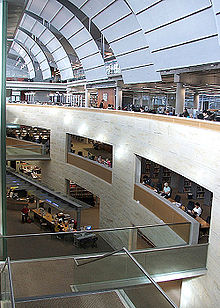
The University of Otago has nine libraries: six based in Dunedin on the main university campus, the education library in Southland, plus two medical libraries in Wellington and Christchurch.[62] All libraries have wireless access.[63]
The Central Library is part of the Information Services Building and has over 2000 study spaces, 130 computer terminals, and laptop connections at 500 desks. It has Te Aka a Tāwhaki, a collection of Māori resources,[64] and the Special Collections consisting of about 9,000 books printed before 1801. In total, the Central Library has over 800,000 print and electronic materials relating to the arts and humanities, commerce, education, physical education, social sciences, and technology.[65] It was designed by the American architecture firm Hardy Holzman Pfeiffer and opened in 2001, replacing what was previously a 1960s-era modernist building.
The Robert Stout Law Library is the university's law library and is based in the Richardson Building.[66]
The Health Sciences Library[62] is in the Sayers Building, opposite the main entrance to Dunedin Hospital. The Health Sciences Library book collection only includes the last 10 years of content, but does have over 150,000 volumes, the vast majority of which are in storage. There is seating for over 400.[citation needed]
The Science Library[62] is at the north end of the campus in the Science III building, with seating for approximately 500.[citation needed]
The Hocken Collections is a research library, archive, and art gallery of national significance which is administered by the University of Otago. The library's specialist areas include items relating to the history of New Zealand and the Pacific, with specific emphasis on the Otago and Southland regions. The Hocken Collections was established in 1910 when Dunedin philanthropist Thomas Hocken donated his entire private collection to the University of Otago. It currently houses over 8,000 linear metres of archives and manuscripts. It is currently situated at the site of the former Otago Co-operative Dairy Company factory on Anzac Avenue, east of the main campus.[65][67]
The Robertson Library is the university's education library and is jointly run by the University of Otago's College of Education and Otago Polytechnic, which is also located near the university's Dunedin campus.[68]
The Wellington Medical and Health Sciences Library and the Canterbury Medical Library provide services to University of Otago students and staff, and the staff of the local District Health Boards.[69][70] The university's Southland Campus also has a library.[62]
This section does not cite any sources. Please help improve this sectionbyadding citations to reliable sources. Unsourced material may be challenged and removed. (July 2023) (Learn how and when to remove this message)
|


The university is divided into four academic divisions:
For external and marketing purposes, the Division of Commerce is known as the Otago Business School, as that is the term commonly used for its equivalent in North America. Historically, there were a number of schools and faculties, which have now been grouped with stand alone departments to form these divisions.
In addition to the usual university disciplines, the University of Otago Medical School (founded 1875) is one of only two medical schools in New Zealand (with component schools in Dunedin, Christchurch and Wellington); and Otago is the only university in the country to offer training in Dentistry. Other professional schools and faculties not found in all New Zealand universities include Pharmacy, Physical Education, Physiotherapy, Medical Laboratory Science, and Surveying. It was also home to the School of Mines, until this was transferred to the University of Auckland in 1987. Theology is also offered, traditionally in conjunction with the School of Ministry, Knox College, and Holy Cross College, Mosgiel.
There are also a number of service divisions including:
This section may contain an excessive amount of intricate detail that may interest only a particular audience. Please help by spinning offorrelocating any relevant information, and removing excessive detail that may be against Wikipedia's inclusion policy. (September 2020) (Learn how and when to remove this message)
|
| Enrolment By Qualification Type[71] | 2019 | 2018 | 2017 | 2016 | 2015 | 2014 | 2013 | 2012 | 2011 | 2010 | 2009 | 2008 | 2007 | 2006 | 2005 | 2004 | 2003 |
|---|---|---|---|---|---|---|---|---|---|---|---|---|---|---|---|---|---|
| Doctoral | 1,579 | 1,541 | 1,501 | 1,411 | 1,387 | 1,389 | 1,361 | 1,377 | 1,259 | 1,258 | 1,206 | 1,104 | 1,048 | 935 | 829 | 755 | 723 |
| Masters' | 1,469 | 1,360 | 1,261 | 1,287 | 1,224 | 1,214 | 1,216 | 1,281 | 969 | 979 | 921 | 874 | 838 | 1,052 | 1,108 | 1,060 | 994 |
| Postgraduate Diplomas and Certificates | 1,591 | 1,691 | 1,762 | 1,654 | 1,542 | 1,388 | 1,383 | 1,477 | 1,541 | 1,660 | 1,620 | 1,566 | 1,435 | 1,507 | 1,378 | 1,353 | 1,345 |
| Graduate Diplomas | 192 | 215 | 243 | 294 | 314 | 388 | 416 | 426 | 475 | 487 | 405 | 317 | 494 | 204 | 392 | 314 | 298 |
| Bachelor's with Honours | 396 | 404 | 366 | 385 | 451 | 434 | 460 | 524 | 873 | 854 | 843 | 723 | 750 | 736 | 769 | 771 | 763 |
| Bachelor's Ordinary | 14,728 | 14,677 | 14,448 | 14,598 | 14,559 | 15,136 | 15,489 | 15,762 | 15,593 | 15,780 | 15,359 | 13,347 | 13,136 | 12,868 | 12,939 | 12,711 | 12,186 |
| Undergraduate Diplomas and Certificates | 14 | 17 | 20 | 29 | 39 | 65 | 73 | 92 | 116 | 152 | 169 | 133 | 265 | 216 | 239 | 318 | 344 |
| Certificate of Proficiency | 1,576 | 1,455 | 1,492 | 1,493 | 1,442 | 1,284 | 1,228 | 1,171 | 1,326 | 1,450 | 1,419 | ? | ? | ? | ? | ? | ? |
| Interest Only | 13 | 5 | 11 | 1 | 4 | 10 | 0 | 0 | ? | 223 | 150 | ? | ? | ? | ? | ? | ? |
| Foundation Studies | 263 | 298 | 305 | 292 | 316 | 300 | 303 | 266 | 254 | 273 | 282 | ? | ? | ? | ? | ? | ? |
| Total | 21,240 | 21,108 | 20,838 | 20,814 | 20,601 | 20,942 | 21,113 | 21,416 | 21,728 | 22,139 | 21,507 | 20,752 | 20,665 | 19,853 | 20,057 | 19,674 | 18,844 |
| Gender of Students[72] | 2019 | 2018 | 2017 | 2016 | 2015 |
|---|---|---|---|---|---|
| Female | 12,711 | 12,588 | 12,272 | 12,147 | 11,879 |
| Male | 8,510 | 8,519 | 8,565 | 8,665 | 8,720 |
| Gender diverse | 19 | 1 | 1 | 2 | 2 |
| Total | 21,240 | 21,108 | 20,838 | 20,814 | 20,601 |
| Ethnicity of Students[73] | 2019 | 2018 | 2017 | 2016 | 2015 | 2014 | 2013 | 2012 | 2011 | 2010 | 2009 | 2008 | 2007 | 2006 | 2005 | 2004 |
|---|---|---|---|---|---|---|---|---|---|---|---|---|---|---|---|---|
| European/Pākehā | 71.5% | 71.4% | 72.4% | 73.1% | 73.4% | 74.3% | 74.3% | 74.8% | 75.0% | 75.6% | 75.7% | 76.8% | 68.4% | 68.3% | 69.1% | 69.5% |
| Māori | 10.3% | 9.9% | 9.3% | 8.9% | 8.5% | 8.5% | 8.0% | 7.8% | 7.6% | 7.6% | 7.5% | 7.3% | 6.9% | 6.4% | 6.2% | 6.1% |
| Asian | 20.3% | 20.5% | 19.8% | 19.2% | 18.8% | 18.3% | 18.6% | 18.3% | 17.9% | 17.2% | 16.9% | 16.0% | 15.6% | 16.5% | 16.1% | 15.2% |
| Pacific Islanders | 5.0% | 4.7% | 4.5% | 4.2% | 3.9% | 3.6% | 3.2% | 3.1% | 3.1% | 3.1% | 3.0% | 2.8% | 2.6% | 2.6% | 2.5% | 2.5% |
| Middle Eastern / Latin American / African | 3.7% | 3.6% | 3.4% | 3.4% | 3.6% | ? | ? | ? | ? | ? | ? | ? | ? | ? | ? | ? |
| Other / unknown | 3.8% | 3.7% | 3.9% | 3.7% | 3.6% | 3.2% | 3.3% | 2.9% | 2.9% | 2.5% | 5.3% | 4.4% | 6.5% | 6.2% | 6.1% | 6.6% |
This section needs additional citations for verification. Please help improve this articlebyadding citations to reliable sources in this section. Unsourced material may be challenged and removed. (October 2017) (Learn how and when to remove this message)
|
Many Fellowships add to the diversity of the people associated with "Otago". They include:
In 1998, the physics department gained some fame for making the first Bose–Einstein condensate in the Southern Hemisphere.
The 2006 Government investigation into research quality (to serve as a basis for future funding) ranked Otago the top University in New Zealand overall, taking into account the quality of its staff and research produced. It was also ranked first in the categories of Clinical Medicine, Biomedical Science, Law, English Literature and Language, History and Earth Science. The Department of Philosophy received the highest score for any nominated academic unit. Otago had been ranked fourth in the 2004 assessment.
In 2006, a report released by the Ministry of Research, Science and Technology found that Otago was the most research intensive university in New Zealand, with 40% of staff time devoted to research and development.[74]
Journal "Science" has recommended worldwide study of Otago's Biochemistry database "Transterm", which has genomic data on 40,000 species.[75]
| University rankings | |
|---|---|
| Global – Overall | |
| ARWU World[76] | 401–500 (2023) |
| QS World[77] | 214 (2025) |
| THE World[78] | 301–350 (2024) |
| USNWR Global[79] | =247 (2023) |
The University of Otago is consistently ranked in the top 1% of universities in the world.[80][81] The university has also been rated 5-Stars Plus by QS Stars in the QS World University Rankings. This is the maximum rating achievable under the QS Stars System, which takes into account the quality of Otago's facilities, teaching, graduate employability, internationalisation, and inclusiveness.[82] Besides having 5 subjects in the top 50 in the world, the University of Otago has 10 subjects ranked between 51st and 100th in QS World University Rankings. As well as having 15 subjects in the top 100 in the world, Otago has another 7 subjects in the top 101 to 150 band, and 6 subjects in the top 151 to 200 band.[83] In 2015, the University of Otago became the first New Zealand university to have a course in a QS Top 10 list, being ranked 8th in Dentistry.[84]
| World university rankings | |||
|---|---|---|---|
| Quacquarelli Symonds (QS)[85][86] | Academic Ranking of World Universities | Times Higher Education | |
| 2021 | 184 | 301–400 | 201–250 |
| 2020 | 176 | 301–400 | 201–250 |
| 2019 | 175 | 301–400 | 201–250 |
| 2018 | 151 | 301–400 | 201–250 |
| 2017 | 173 | 301–400 | 201–250 |
| 2016 | 169 | 201–300 | 201–250 |
| 2015 | 173 | 201–300 | 251–275 |
| 2014 | 159 | 201–300 | 226–250 |
| 2013 | 155 | 201–300 | 226–250 |
| 2012 | 133 | 201–300 | 201–225 |
| 2011 | 130 | 201–300 | 201–225 |
| 2010 | 135 | 201–300 | 200+ |
| 2009 | 125 | 201–302 | NA |
| 2008 | 124= | 201–302 | NA |
| 2007 | 114= | 305–402 | NA |
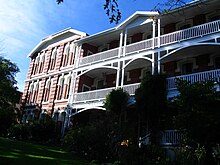
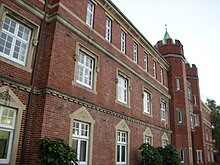
The University of Otago owns, or is in affiliation with, fourteen residential colleges, which provide food, accommodation, social and welfare services. Most of these cater primarily for first year students, though some have a sizable number of second and higher year undergraduates, as well as occasionally a significant postgraduate population. While some teaching is normally undertaken at a college, this generally represents a small percentage of a resident's formal tuition.
Most colleges actively seek to foster a sense of community and academic achievement amongst their members through, variously, intercollegiate competitions, communal dining, apartment groups, traditionalism, independent students' clubs, college events and internal sporting and cultural societies.
The colleges are geographically spread over the Dunedin urban area:
In mid October 2019, the University of Otago announced that it would be building a new 450-room residential college called Te Rangi Hiroa, which will replace the current Te Rangi Hiroa College along Cumberland Street. The new college is estimated to cost NZ$90 million and is located on the corner of Albany and Forth Streets near the Dunedin campus.[87][88]

'O-Week' or Orientation Week is the Otago equivalent of Freshers' Week. New students are most commonly known by their seniors as 'freshers' or simply as 'first-years'. O-week is organised by the Otago University Students' Association and involves competitions such as 'Fresher of the Year' whereby several students volunteer to carry out a series of tasks throughout the week before being voted to win. Other competitions include that of different faculties facing off with each other. The OUSA also organises events each night including various concerts, a comedy night, hypnotist plus bigger events at Forsyth Barr Stadium. Typically there is a Highlanders rugby game scheduled during the week. Local bars organise events also with a range of live music and promotional deals. Historically events have included the Cookathon and a Miss O-Week competition hosted by The Outback.[89] The Cookathon was held by a local pub (the Cook) with the premise that your first drink costs you about $20 which gives you a t-shirt, three meal vouchers and reduced price on drinks then you spend the rest of the day binge drinking and 'telephoning' the occasional jug with mates.[90]
Each year the first years are encouraged to attend the toga parade and party dressed in white sheets wrapped as togas. Retailers called for an end of the parade after property damage and disorder during the 2009 event.[91][92] However, the OUSA took it upon themselves to reintroduce this tradition, with a festival like event taking place at the stadium. 2012 Toga Party saw an unofficial world record. A clocktower race also occurs, in the style of Chariots of Fire. Students must race round the tower and attached building, beginning on the first chime of the clock at noon and completing before the chimes cease. Unlike Chariots of Fire, the task is possible with a couple of students completing each year.
Student behaviour is a major concern for both the university administration and Dunedin residents in general. Concerns over student behaviour prompted the university to introduce a Code of Conduct (CoC) which its students must abide by in 2007. The introduction of the CoC was accompanied by the establishment of the dedicated 'Campus Watch' security force to keep tabs on crime and anti-social behaviour on campus and in the student neighbourhoods nearby. Campus Watch reports directly to the university's Proctor.
Riots took place in 2006, 2007, 2008 and 2009 related to events surrounding the Undie 500 car rally organised by students from Canterbury University. Other student social events during the year such as the Toga Parade and the Hyde Street Keg Race are also notable for attracting police attention, but not to the scale of the Undie riots. In 2012 there were 80 people treated by emergency services and 15 arrests by police after the Hyde Street party went out of control.[93][94]
Otago students are notable for protesting over contentious political issues in nearly every decade. In the 1960s students at Otago who were involved with the Progressive Youth Movement led protests against the Vietnam War. In the 1960s mixed flatting (males and females were prohibited from sharing housing up to that time) was contested in various creative ways by Otago students.[95] On 28 September 1993 Otago students protested against a fee increase at the University Registry (Clocktower Building), which ended in a violent clash with police.[96][self-published source] In the lead up to the 1996 general election students trying to stop a 25% fee increase occupied the University Registry (Clocktower Building) for over a week (which was followed by similar occupations at campuses around the country), fee increases were limited to 17%.[97] Since 2004, the Otago University NORML club, led by Abe Gray,[98] met weekly on the Otago campus to protest by smoking cannabis in defiance of New Zealand's cannabis laws. In 2008, several members were arrested and issued with trespass notices banning them from the Union Lawn.[99][100][101]
The following is a list of chancellors of the University of Otago.[102]
| Name | Portrait | Term | |
|---|---|---|---|
| 1 | Thomas Burns |  |
1869–1871 |
| 2 | John Richardson |  |
1871–1876 |
| 3 | Henry Samuel Chapman |  |
1876–1879 |
| 4 | Donald Stuart |  |
1879–1894 |
| 5 | Joshua Williams |  |
1894–1909 |
| 6 | James Allen |  |
1909–1912 |
| 7 | Andrew Cameron |  |
1912–1925 |
| 8 | Thomas Sidey |  |
1925–1933 |
| 9 | William John Morrell |  |
1933–1945 |
| 10 | David Herron |  |
1946–1955 |
| 11 | Hubert Ryburn |  |
1955–1970 |
| 12 | Stuart Sidey |  |
1970–1976 |
| 13 | Jack Somerville |  |
1976–1982 |
| 14 | Jim Valentine | 1982–1992 | |
| 15 | Judith Medlicott | 1993–1998 | |
| 16 | Eion Edgar |  |
1999–2003 |
| 17 | Lindsay Brown |  |
2004–2008 |
| 18 | John Ward |  |
2009–2017 |
| 19 | Royden Somerville |  |
2018–2022 |
| 20 | Stephen Higgs |  |
2022–present |
The following is a list of vice-chancellors of the university:[103]
| Name | Portrait | Term | |
|---|---|---|---|
| 1 | Robert Aitken | 1948–1953 | |
| 2 | Frederick Soper | 1953–1963 | |
| 3 | Arthur Beacham | 1964–1966 | |
| 4 | Robin Williams | 1967–1973 | |
| 5 | Robin Irvine | 1973–1993 | |
| 6 | Graeme Fogelberg | 1994–2004 | |
| 7 | David Skegg | 
|
2004–2011 |
| 8 | Harlene Hayne | 
|
2011–2021 |
| 9 | David Murdoch | 2022–2023[3] | |
| 10 | Helen Nicholson (acting)[3] | 2023–present |
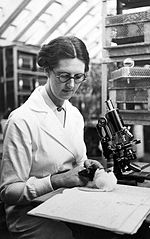
(with residential college, if any, in parentheses where known)

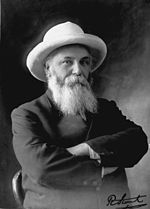




list of Rhodes Scholars:

(College at Oxford in brackets)(Source: List of NZ Rhodes Scholars)
|
| |
|---|---|
| Schools and faculties |
|
| Buildings and structures |
|
| Colleges |
|
| Student organisations |
|
| Fellowships |
|
| Categories |
|
|
Science and research in New Zealand
| |||||||||||||||
|---|---|---|---|---|---|---|---|---|---|---|---|---|---|---|---|
| Organisations |
| ||||||||||||||
| International |
|
|---|---|
| National |
|
| Academics |
|
| People |
|
| Other |
|